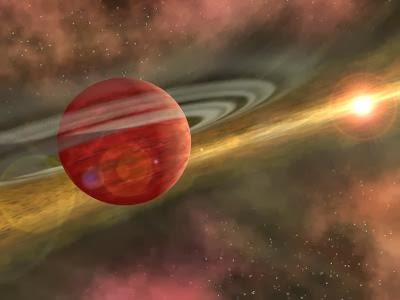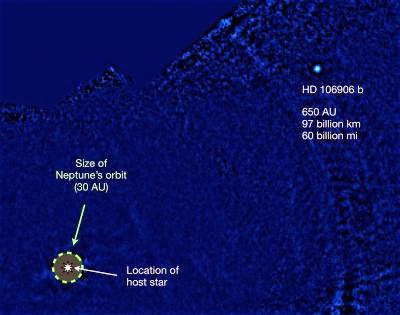

| Visitors Now: | |
| Total Visits: | |
| Total Stories: |

| Story Views | |
| Now: | |
| Last Hour: | |
| Last 24 Hours: | |
| Total: | |
Impossible Planet Found Throwing A Wrench Into Planet Formation Theories
Weighing in at 11 times Jupiter’s mass and orbiting its star at 650 times the average Earth-Sun distance, planet HD 106906 b is unlike anything in our own Solar System and throws a wrench in planet formation theories.
This is an artist’s conception of a young planet in a distant orbit around its host star. The star still harbors a debris disk, remnant material from star and planet formation, interior to the planet’s orbit (similar to the HD106906 system).

Credit: NASA/JPL-Caltech
“This system is especially fascinating because no model of either planet or star formation fully explains what we see,” said Vanessa Bailey, who led the research. Bailey is a fifth-year graduate student in the UA’s Department of Astronomy.
It is thought that planets close to their stars, like Earth, coalesce from small asteroid-like bodies born in the primordial disk of dust and gas that surrounds a forming star. However, this process acts too slowly to grow giant planets far from their star. Another proposed mechanism is that giant planets can form from a fast, direct collapse of disk material. However, primordial disks rarely contain enough mass in their outer reaches to allow a planet like HD 106906 b to form. Several alternative hypotheses have been put forward, including formation like a mini binary star system.
“A binary star system can be formed when two adjacent clumps of gas collapse more or less independently to form stars, and these stars are close enough to each other to exert a mutual gravitation attraction and bind them together in an orbit,” Bailey explained. “It is possible that in the case of the HD 106906 system the star and planet collapsed independently from clumps of gas, but for some reason the planet’s progenitor clump was starved for material and never grew large enough to ignite and become a star.”
According to Bailey, one problem with this scenario is that the mass ratio of the two stars in a binary system is typically no more than 10-to-1.
“In our case, the mass ratio is more than 100-to-1,” she explained. “This extreme mass ratio is not predicted from binary star formation theories – just like planet formation theory predicts that we cannot form planets so far from the host star.”
This system is also of particular interest because researchers can still detect the remnant “debris disk” of material left over from planet and star formation.
“Systems like this one, where we have additional information about the environment in which the planet resides, have the potential to help us disentangle the various formation models,” Bailey added. “Future observations of the planet’s orbital motion and the primary star’s debris disk may help answer that question.”
At only 13 million years old, this young planet still glows from the residual heat of its formation. Because at 2,700 Fahrenheit (about 1,500 degrees Celsius) the planet is much cooler than its host star, it emits most of its energy as infrared rather than visible light. Earth, by comparison, formed 4.5 billion years ago and is thus about 350 times older than HD 106906 b.

Credit: Vanessa Bailey
UA astronomy professor and MagAO principal investigator Laird Close said: “MagAO was able to utilize its special Adaptive Secondary Mirror, with 585 actuators, each moving 1,000 times a second, to remove the blurring of the atmosphere. The atmospheric correction enabled the detection of the weak heat emitted from this exotic exoplanet without confusion from the hotter parent star.”
“Clio was optimized for thermal infrared wavelengths, where giant planets are brightest compared to their host stars, meaning planets are most easily imaged at these wavelengths,” explained UA astronomy professor and Clio principal investigator Philip Hinz, who directs the UA Center for Astronomical Adaptive Optics.
The team was able to confirm that the planet is moving together with its host star by examining Hubble Space Telescope data taken eight years prior for another research program. Using the FIRE spectrograph, also installed at the Magellan telescope, the team confirmed the planetary nature of the companion. “Images tell us an object is there and some information about its properties but only a spectrum gives us detailed information about its nature and composition,” explained co-investigator Megan Reiter, a graduate student in the UA Department of Astronomy. “Such detailed information is rarely available for directly imaged exoplanets, making HD 106906 b a valuable target for future study.”
“Every new directly detected planet pushes our understanding of how and where planets can form,” said co-investigator Tiffany Meshkat, a graduate student at Leiden Observatory in the Netherlands. “This planet discovery is particularly exciting because it is in orbit so far from its parent star. This leads to many intriguing questions about its formation history and composition. Discoveries like HD 106906 b provide us with a deeper understanding of the diversity of other planetary systems.”
The research paper, “HD 106906 b: A Planetary-mass Companion Outside a Massive Debris Disk,” has been accepted for publication in The Astrophysical Journal Letters and will appear in a future issue. An online version is available for download at http://arxiv.org/abs/1312.1265 .
MagAO’s development was funded by the National Science Foundation’s Major Research Instrumentation program, and its Telescope System Instrumentation Program and an Advanced Technologies and Instrumentation Award.
The members of the discovery team are Vanessa Bailey (UA), Tiffany Meshkat (Leiden Observatory [LO]), Megan Reiter (UA), Katie Morzinski (UA), Jared Males (UA), Kate Y. L. Su (UA), Philip M. Hinz (UA), Matthew Kenworthy (LO), Daniel Stark (UA), Eric Mamajek (University of Rochester), Runa Briguglio (Arcetri Observatory [AO]), Laird M. Close (UA), Katherine B. Follette (UA), Alfio Puglisi (AO), Timothy Rodigas (UA, Carnegie Institute of Washington [CIW]), Alycia J. Weinberger (CIW), and Marco Xompero (AO).
Contacts and sources;
University of Arizona
Links:
Research paper: http://arxiv.org/abs/1312.1265
MagAO system: https://visao.as.arizona.edu
Source:




A bit like the elusive Nibiru/Wormwood/Hercobulus/Planet X then?
“ha-ha, think your ‘science’ knows so much!”, says God.
These clever people must feel like rabbits in the headlights of the ten-ton truck called reality. Or toreadors waving a red handkerchief at a charging bull. Or patriots hiding behind a piece of paper called The Constitution whilst being anally raped and tasered by police officers after crossing a stop sign.
None of their explanations about anything are correct. How embarrassing! Millions of dollars, thousands of learned papers, dozens of Nobel Prizes, endless appearances on TV; telescopes named after themselves, entire space missions, top-selling popular science books…and still, they know nothing.
“And they shall turn away their ears from the truth, and shall be turned unto fables”.
“Professing themselves to be wise, they became fools”.
“For the invisible things of Him from the creation of the world are clearly see, being understood by the things that are made, even His eternal power and Godhead, so that they are without excuse…”
WELL THE earth is not flat
It’s not exactly spherical either
We need to learn what’s being said in these kind of articles. It’s not about the planet itself, big deal there’s millions more of them.
It’s about the gee-whiz, whiz-bang Optics System it took four full paragraphs to tell us about.
You know you want it. You know you need it. Now you know we make it and want to sell it to you.
Down to Earth
The real issue is with the Cult of Academia, if any real scientists dare think outside the boundaries of the prescribed doctrine then they are ostracized and burnt at the career stake like the witches of old. (http://www.miamiherald.com/2013/12/06/3801661/nobel-winner-scientists-get-it.html)
Our current scientific body of knowledge is rife with known frauds that are still printed in the text books that are taught to our children as fact even though proven false up to half a century past.
When you do the math yourself it becomes very obvious that gravity has only a small part to play in the formation of these bodies. Gravity does play an important part but is limited by distance i.e. F=(G*M1*M2)/R^2 which becomes miniscule volumetrically with regards to distance whereas electro-static and electro-magnetic forces that have a +/- nature not just attractive as gravity and have orders of magnitude greater influence with regards to distance. All the models need revising
It’s a little bit like the on going dramas over “Global Warming” where the loudest voices who stand to gain the most financially have conveniently left “inconvenient variables” out of the equation like the big bright glowing thing in the sky that actually provides all the energy that reaches earth (solar maximum = more energy reaching earth) but must ignore that fact so new taxes can be created to fill the wallets of the few.
Science, whos Science? Humans think that they can know all things just like god, Eve was the first to keep delusional thinking, So called Science has been wrong since it began, history will continue to show us the way.
main stream astronomers must finally understand that what is “impossible” is only impossible in their outdated books and minds!
Nah…THIS planet is real.